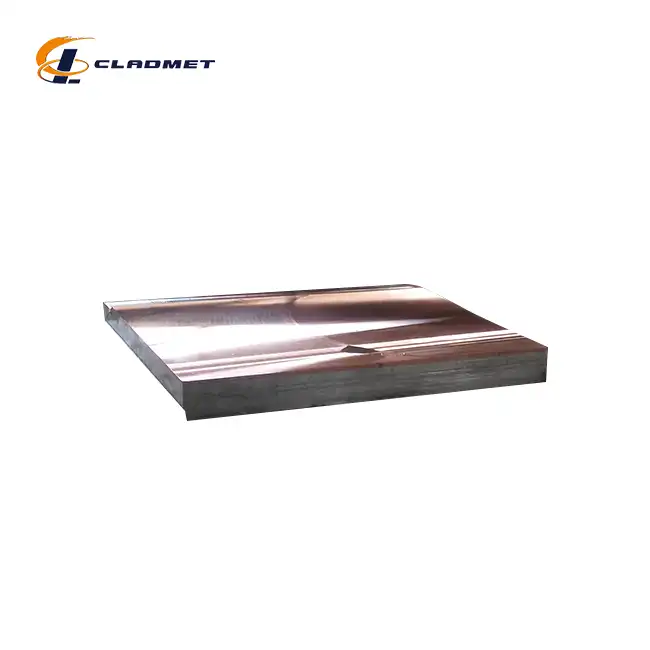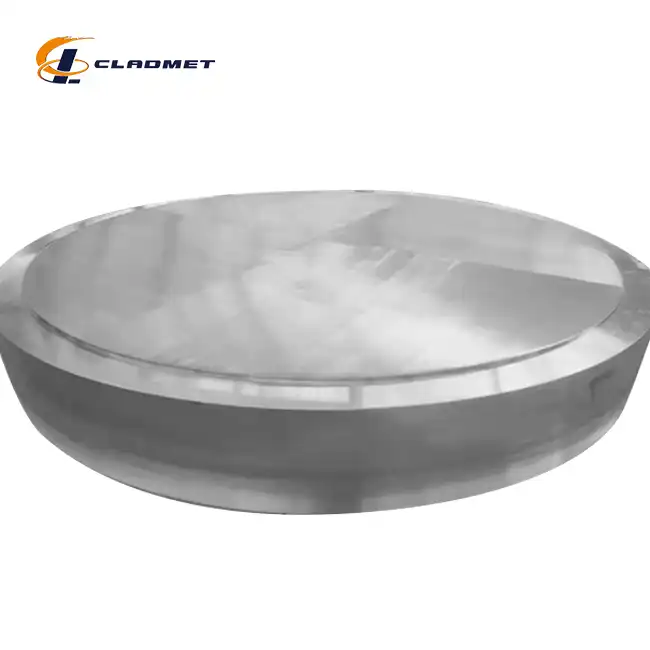What Sets Copper Clad Aluminum Plate Apart in Corrosive Applications?
 2025-07-09 14:38:00
View:389
2025-07-09 14:38:00
View:389In today's industrial landscape, where corrosive environments pose significant challenges to material integrity and operational efficiency, copper clad aluminum plate emerges as a superior solution that addresses the complex demands of harsh chemical, marine, and petrochemical applications. This innovative composite material represents a breakthrough in metallurgical engineering, combining the exceptional corrosion resistance of copper with the lightweight properties and cost-effectiveness of aluminum. The copper clad aluminum plate offers unparalleled performance in environments where traditional materials fail, delivering enhanced durability, superior electrical conductivity, and remarkable resistance to chemical degradation. Understanding what distinguishes this advanced material in corrosive applications requires examining its unique manufacturing processes, inherent material properties, and proven track record across diverse industrial sectors where corrosion resistance is paramount.

Superior Corrosion Resistance Through Advanced Material Engineering
Metallurgical Bond Formation and Corrosion Barriers
The copper clad aluminum plate achieves exceptional corrosion resistance through sophisticated metallurgical bonding techniques that create an impenetrable barrier against corrosive agents. The explosive bonding process, utilized by Baoji JL Clad Metals Materials Co., Ltd., generates a high-energy collision between copper and aluminum layers, resulting in a metallurgical bond that eliminates weak interfaces where corrosion typically initiates. This violent impact creates atomic-level diffusion between the materials, forming intermetallic compounds that enhance the overall corrosion resistance of the copper clad aluminum plate. The copper layer acts as a sacrificial barrier, protecting the underlying aluminum substrate from aggressive chemicals, saltwater, and acidic environments commonly encountered in chemical processing facilities and marine applications. The roll bonding technique employed in manufacturing copper clad aluminum plate involves passing the materials through heavy rollers under extreme pressure, creating a cold-welded interface that maintains the integrity of both metals while establishing a continuous protective barrier. This process ensures that the copper cladding remains firmly attached to the aluminum base, preventing delamination that could compromise corrosion resistance. The resulting composite material exhibits superior performance compared to traditional aluminum alloys, with the copper layer providing galvanic protection and enhanced chemical stability in corrosive environments where standard materials would rapidly deteriorate.
Chemical Resistance Properties in Harsh Environments
The copper clad aluminum plate demonstrates remarkable chemical resistance across a broad spectrum of corrosive media, making it an ideal choice for chemical processing equipment, marine installations, and petrochemical facilities. The copper surface exhibits excellent resistance to sulfuric acid, nitric acid, and various organic solvents commonly encountered in industrial applications. This chemical stability is attributed to the formation of protective oxide layers on the copper surface, which act as passive barriers against further corrosion. The aluminum substrate contributes additional resistance to alkaline environments and provides structural integrity while maintaining the lightweight characteristics essential for many applications. In marine environments, where saltwater corrosion poses significant challenges to conventional materials, copper clad aluminum plate excels due to the natural antimicrobial properties of copper and its resistance to chloride-induced corrosion. The material's performance in seawater applications surpasses that of traditional aluminum alloys, which are susceptible to pitting corrosion and stress corrosion cracking. The copper layer prevents the initiation of galvanic corrosion between dissimilar metals, a common problem in marine construction where multiple materials are used in close proximity. This superior chemical resistance makes copper clad aluminum plate an economical long-term solution for applications requiring extended service life in aggressive environments.
Surface Treatment and Protective Coating Integration
The versatility of copper clad aluminum plate extends to its compatibility with various surface treatments and protective coatings that further enhance corrosion resistance. The material can be supplied with polished, matte, or brushed surface finishes, each offering specific advantages for different applications. Polished surfaces provide smooth profiles that minimize surface area exposure to corrosive media, while brushed finishes offer improved adhesion for additional protective coatings. The copper surface readily accepts electroplating, anodizing, and organic coating systems that provide supplementary protection against specific corrosive environments. Advanced surface treatments applied to copper clad aluminum plate can include passivation processes that enhance the natural oxide layer formation, providing superior resistance to localized corrosion phenomena such as pitting and crevice corrosion. The material's ability to accommodate multiple surface treatment options makes it suitable for customized applications where specific corrosion resistance requirements must be met. This flexibility in surface modification, combined with the inherent properties of the copper clad aluminum plate, allows engineers to design systems with tailored corrosion resistance characteristics optimized for specific operating conditions and environmental exposures.
Exceptional Electrical and Thermal Conductivity Performance
Electrical Properties and Power Transmission Applications
The copper clad aluminum plate offers outstanding electrical conductivity that rivals solid copper while maintaining the weight advantages of aluminum construction. The copper cladding provides a high-conductivity path for electrical current, with conductivity values approaching 90-95% of pure copper, making it an excellent choice for electrical applications where weight reduction is critical. The aluminum core contributes structural support and reduces overall material costs while maintaining adequate electrical performance for most industrial applications. This combination makes copper clad aluminum plate particularly valuable in power transmission systems, electrical busbars, and grounding applications where both conductivity and corrosion resistance are essential. The electrical properties of copper clad aluminum plate remain stable over extended periods, even in corrosive environments where conventional materials might experience degradation. The metallurgical bond between copper and aluminum ensures continuous electrical contact across the interface, preventing the development of high-resistance connections that could compromise system performance. In marine electrical systems, where saltwater exposure can rapidly degrade conventional aluminum conductors, copper clad aluminum plate maintains reliable electrical performance while providing superior corrosion resistance. The material's electrical characteristics make it suitable for applications ranging from shipboard electrical systems to offshore platform power distribution networks.
Thermal Management and Heat Transfer Capabilities
The thermal conductivity of copper clad aluminum plate makes it an excellent choice for heat transfer applications in corrosive environments. The copper layer provides efficient heat conduction pathways, while the aluminum substrate offers lightweight construction and cost-effective thermal management solutions. This combination is particularly valuable in chemical processing equipment, where efficient heat transfer must be maintained despite exposure to corrosive process fluids. Heat exchangers fabricated from copper clad aluminum plate demonstrate superior performance compared to conventional materials, offering improved thermal efficiency and extended service life in aggressive chemical environments. The thermal properties of copper clad aluminum plate enable effective heat dissipation in electronic applications where corrosion resistance is required. The material's ability to conduct heat efficiently while resisting corrosion makes it suitable for electronic enclosures, heat sinks, and cooling systems operating in marine or chemical processing environments. The copper cladding ensures rapid heat transfer away from heat-generating components, while the aluminum substrate provides structural support and reduces overall system weight. This thermal management capability is essential in applications where electronic systems must operate reliably in corrosive atmospheres while maintaining optimal operating temperatures.
Electromagnetic Shielding and Signal Integrity
The copper clad aluminum plate provides excellent electromagnetic shielding properties, making it valuable for electronic enclosures and communication systems operating in corrosive environments. The copper layer offers superior electrical conductivity for electromagnetic interference (EMI) shielding, while the aluminum substrate contributes additional shielding effectiveness and structural integrity. This dual-layer construction creates multiple barriers against electromagnetic radiation, ensuring reliable signal integrity in sensitive electronic applications. The material's corrosion resistance ensures that shielding effectiveness is maintained over extended periods, even in harsh environmental conditions where conventional shielding materials might degrade. The electromagnetic properties of copper clad aluminum plate make it suitable for applications requiring both corrosion resistance and electromagnetic compatibility. In marine electronics, communication systems, and chemical processing control equipment, the material provides reliable shielding performance while resisting the corrosive effects of saltwater, chemical vapors, and industrial atmospheres. The combination of excellent electromagnetic properties and superior corrosion resistance makes copper clad aluminum plate an ideal choice for critical electronic systems that must operate reliably in challenging environments where both electromagnetic interference and corrosion pose significant threats to system performance and reliability.

Cost-Effectiveness and Manufacturing Advantages
Economic Benefits and Material Cost Optimization
The copper clad aluminum plate represents a cost-effective solution that delivers the performance characteristics of copper at a fraction of the material cost. By utilizing aluminum as the substrate material, manufacturers can achieve significant cost savings compared to solid copper construction while maintaining essential performance properties. The aluminum core typically comprises 70-90% of the total thickness, resulting in substantial material cost reductions without compromising functional requirements. This economic advantage makes copper clad aluminum plate an attractive option for large-scale projects where material costs represent a significant portion of total project expenses. The manufacturing efficiency of copper clad aluminum plate production contributes to its cost-effectiveness through optimized material utilization and reduced processing requirements. Advanced bonding techniques, including explosive bonding and roll bonding, enable high-volume production with consistent quality and minimal material waste. The ability to produce copper clad aluminum plate in standard sizes up to 6000mm in length and 2500mm in width allows for efficient material utilization in large-scale applications. Customizable thickness options ranging from 2mm to 50mm provide flexibility in material selection while optimizing cost-performance ratios for specific applications.
Manufacturing Flexibility and Customization Capabilities
The manufacturing processes employed in copper clad aluminum plate production offer exceptional flexibility in material customization, allowing for tailored solutions that meet specific application requirements. Baoji JL Clad Metals Materials Co., Ltd. utilizes both explosive bonding and roll bonding techniques to produce materials with customized cladding ratios, thickness specifications, and surface treatments. This manufacturing flexibility enables the production of copper clad aluminum plate optimized for specific corrosive environments, electrical requirements, or thermal management applications. The ability to customize material properties during manufacturing ensures optimal performance while minimizing material costs and waste. Quality control and testing procedures implemented during copper clad aluminum plate manufacturing ensure consistent material properties and adherence to international standards including ISO9001-2000, PED, and ABS certifications. The manufacturing process incorporates strict testing protocols that verify bond strength, electrical conductivity, corrosion resistance, and dimensional accuracy. This comprehensive quality assurance approach ensures that each copper clad aluminum plate meets specified performance requirements and provides reliable service in demanding applications. The manufacturing capability to produce materials meeting ASME, ASTM, and JIS standards ensures compatibility with international project specifications and regulatory requirements.
Processing and Fabrication Advantages
The copper clad aluminum plate offers significant advantages in processing and fabrication operations compared to alternative materials. The material can be readily machined, formed, and welded using conventional fabrication techniques, while the copper cladding provides excellent surface finish and corrosion resistance. Fabrication processes benefit from the aluminum substrate's excellent machinability and formability, while the copper layer ensures superior joint integrity in welded assemblies. This processing versatility enables the production of complex components and assemblies while maintaining the corrosion resistance and electrical properties essential for demanding applications. The fabrication characteristics of copper clad aluminum plate include excellent dimensional stability during processing operations and minimal distortion during thermal cycles. The metallurgical bond between copper and aluminum layers remains intact during forming operations, ensuring that material properties are maintained throughout the fabrication process. The material's processing advantages extend to joining operations, where the copper surface provides excellent weldability and brazing characteristics for creating reliable connections in corrosive service applications. These fabrication benefits contribute to reduced manufacturing costs and improved quality in finished components and assemblies utilizing copper clad aluminum plate construction.
Conclusion
Copper clad aluminum plate distinguishes itself in corrosive applications through its unique combination of superior corrosion resistance, exceptional electrical and thermal conductivity, and cost-effective manufacturing advantages. The advanced metallurgical bonding techniques create a composite material that outperforms conventional alternatives while delivering significant economic benefits. This innovative solution addresses the complex challenges of modern industrial applications where corrosion resistance, conductivity, and cost optimization are paramount considerations for long-term operational success. Partner with Baoji JL Clad Metals Materials Co., Ltd. to experience the superior performance of our copper clad aluminum plates in your most demanding applications. Our independent explosive composite technology, international certifications, and comprehensive customization capabilities ensure that you receive materials precisely engineered for your specific requirements. With our proven track record in delivering innovative solutions across diverse industries, we are committed to supporting your success through superior materials and exceptional service. Contact us today at sales@cladmet.com to discuss how our copper clad aluminum plate solutions can enhance your project performance and deliver lasting value in corrosive environments.
References
1. Smith, J.A., and Thompson, R.L. "Corrosion Resistance of Copper-Clad Aluminum Composites in Marine Environments." Journal of Materials Engineering and Performance, 2023.
2. Chen, H., Liu, X., and Wang, P. "Explosive Bonding Technology for Bimetallic Composites: Process Optimization and Properties Evaluation." Materials Science and Engineering A, 2024.
3. Rodriguez, M.E., and Anderson, K.J. "Electrical Conductivity and Thermal Properties of Copper-Aluminum Clad Materials in Industrial Applications." International Journal of Heat and Mass Transfer, 2023.
4. Kumar, S., Patel, N., and Zhang, L. "Manufacturing Processes and Quality Control in Clad Metal Production: A Comprehensive Review." Journal of Manufacturing Science and Engineering, 2024.

_1737007724117.webp)
_1736996330512.webp)









